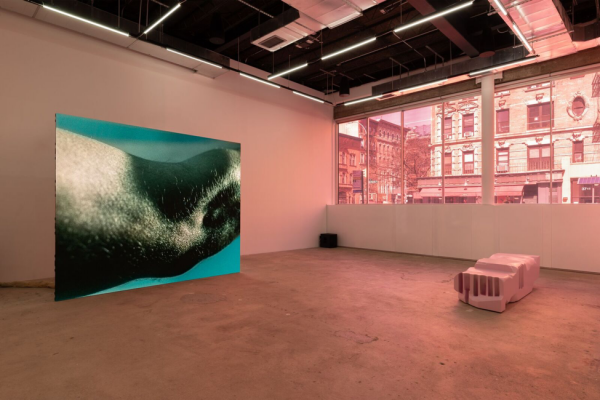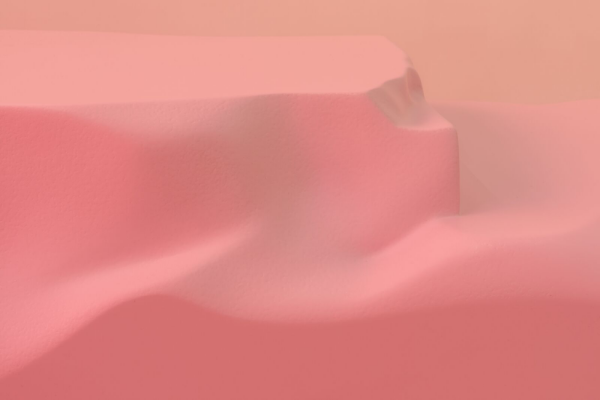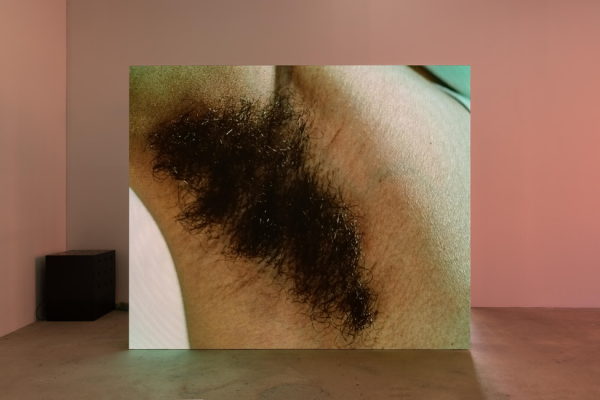“The
notion of the figurative takes on a new meaning when the organic merges with
the synthetic to depict the body as something unfixed, malleable, and remote.”
– Ruba Katrib, How Does it Feel? It Feels Like…Flesh[1]

Shahryar Nashat’s exhibition at Swiss Institute, the artist’s first institutional exhibition in New York, includes a series of new commissions. A video and six sculptures inhabit a space transformed by libidinal pink light. In a separate installation, extruded floor becomes a counter-top for synthetic polymer meat inscribed with words of longing. The exhibition is pertinently untitled with works that resist the notion of naming in favor of categorical slippage.
Nashat uses a broad range of media, including video, sculpture, installation and photography. For the last decade, his subject has been the human body. Like Fernand Leger’s automaton of Ballet Mecanique or Marcel Duchamp’s fleshy dental piece Wedge of Chastity, in Nashat’s work the body’s sensuality, vulnerability, and possibility come into composition with technologies – pixels, synthetics, and prosthetics. In this exhibition, the technological mediation of the body results in both theoretical and formal fragmentation. The fragmentation thwarts recognition and points to an embodied relationship between desire and aggression, peace and war. Start to Beg and its partner Keep Begging are fragmented bodies that articulate these ambiguities.

Start to Beg creates a visceral narrative around its making and condition. The sculpture is a freaky pink polymer prism stretched across the floor. At first it appears like an unfinished carved and polished marble sculpture. Upon closer inspection, it reveals itself to be a cohesive mechanically fabricated object. While the contours and proportions of the form initially seem familiar, biomorphic undulations shift the geometric rectilinearity into a state of flux. Maurice Merleau-Ponty argues that the viewer experiences the minimalist object as the correlate for the body[2]. Similarly, Rosalind Krauss claims that the modernist “totemic sculpture” makes the “statement of the human presence of the subject”[3]. Nashat takes this formalist transubstantiation as an origin point for the work’s narrative. He amplifies the corporeal nature of this body by casting the prism from flesh colored polymer at a human scale. Nude and reclined like a genderless Odalisque, Start to Beg juts upward where a hip would be.
The narrative around this body takes on a macabre tone from the wounds on its surface. Mechanically fabricated bruises and bite marks create a complex relationship: they add to the work’s physical presence but extract from its physical mass, they disrupt the glossy surface and activate it as a site of meaning, they might be violent scars, or love-bites. The indexical haptic mark in sculpture is often a record of the artist’s hand (Rodin, David Smith) tied to a psychological narrative of making. If the index is a physical action imprinted upon the surface that received it, in Start to Beg it is a physical trauma that forms the contours of the sculptural body. The traumas appear like staged imperfections— they are too perfectly fabricated to be literal. Instead, they are external representations of a psychological tension— Nashat makes a seductively homogeneous surface, a perfect object of desire, and then disrupts that superficiality with aggressive excavations into the body’s interior. The tension between the two creative impulses creates an internal drama.

Keep Begging, the only time-based work in the exhibition, can be divided into two sections: stasis, and acceleration. The shift in speed abstracts and fragments the body, and blurs the boundary between peace and war. Paul Virilio writes that speed (stasis and acceleration) is a physical symptom of the endless preparation for war. The body, he argues, has become a “metabolic vehicle” – part organic, part machine – a vector of speed. The anxiety and anticipation of war has fragmented its biological rhythm, even in peacetime.[4] In Keep Begging the camera’s inhuman HD lens magnifies the epidermis on the enormous screen. Repeated muscle flexes and the ticking pulse under the skin, imperceptible at a normal scale, now fire like a running engine. The abstracted arm, isolated from the body and constrained to repeated accelerated movements, becomes a metabolic vehicle.
Stasis:
A low industrial requiem plays. The video on the screen shows an extended close up of an armpit. The camera’s gaze is at once desirous and clinical. It lingers on glistening armpit hair, tracks across bicep, and rests at bare elbow. The overall stasis and narrow focus extend time, and forestall action. The body convalesces in fragile peace.
Acceleration:
A doleful disembodied voice delivers three recurring refrains, “My dear”, “Holidays are over… oops”, “Do we go to war?” The score swells to a climax; the forearm thrusts, flexes, and contracts. The camera’s programmed movement accelerates with precision and agility to mirror the arm’s mechanical choreographed maneuvers. This body verbalizes the shift from peace to apprehension of war and shows its physical threat.
But “Do we go to war?” is never answered. Despite its potential for weaponization, the arm finds repose in the final moments of its performance. The hand tenderly rests at the hip. In Start to Beg and Keep Begging, Nashat collapses binaries: desire and aggression, peace and war. He weaves complex narratives around the production and fragmentation of sculptural bodies. In Start to Beg, a synthetic object is wounded as if it were a body. In Keep Begging, the body is instrumentalized as if it were a machine. In a 2018 interview with Mousse Magazine, he contextualizes the wound, which is the crux of Start to Beg, “An open wound goes beyond the cosmetic and activates the agency of the body because it shows its vulnerability and when a body has agency it becomes political.”[5] Similarly, his 2016 Walker Art Center interview imbues the performative Keep Begging with political narrative, “When you invest the body with actions and gestures you write a narrative for the body. You give it agency.”[6] The narrative agency within the works is highly charged and polarized. The political stakes are palpable, though not clearly articulated. This ambiguity seems highly determined. Ultimately, the answers are not as urgent as the questions: is the fragmentation of the supposedly unified humanist subject necessarily violent? Can it not also empower the body?
-Lucia Zezza, Curatorial Intern
Shahryar Nashat at Swiss Institute is on view from March 20, 2019 to June 2, 2019.
[1] Katrib, Ruba. “It Feels Like…Flesh.” How Does It Feel: Inquiries Into Contemporary Sculpture, 2016, 13-17.
[2] Merleau-Ponty, Maurice. “The Theory of the Body is Already a Theory of Perception” Phenomenology of Perception, trans. Colin Smith, 1962 [1945].
[3] Krauss, Rosalind. Passages in Modern Sculpture, 1977. https://monoskop.org/images/d/d0/Krauss_Rosalind_E_Passages_in_Modern_Sculpture.pdf
[4] Virilio, Paul. Speed and Politics, 1977. https://monoskop.org/images/c/c1/Virilio_Paul_Speed_and_Politics_2006.pdf
[5] Nashat, Shahryar. Interview by Mason Leaver Yap, Walker Art Center Magazine, 2016. https://walkerart.org/magazine/shahryar-nashat-fabian-schoneich-isla-leaver-yap
[6] Nashat, Shahryar. Interview by Mousse, Mousse magazine, 2018. http://moussemagazine.it/image-is-an-orphan-shahryar-nashat-2018/
